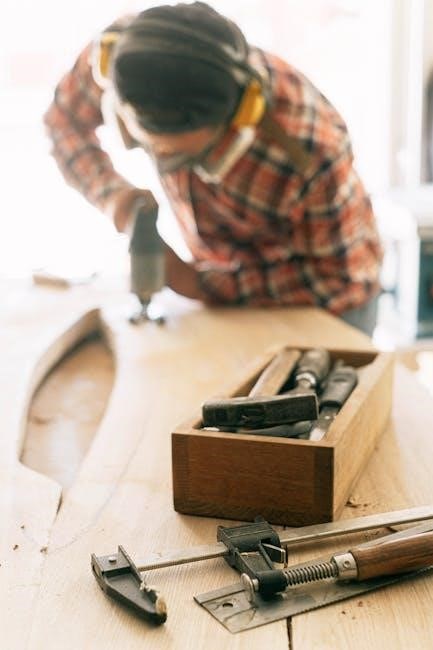The Craftsman Compound Miter Saw Manual offers detailed guidance for setting up‚ operating‚ and maintaining your tool. It ensures optimal performance and safety‚ covering features like the laser guide and blade adjustments.

Safety Precautions and Guidelines
The Craftsman Compound Miter Saw Manual emphasizes safety first. Always wear PPE‚ ensure a stable workspace‚ and handle the saw with care. Follow guidelines to prevent accidents and ensure smooth operations.
Importance of Safety in Using Power Tools
Safety is paramount when operating power tools like the Craftsman Compound Miter Saw. These tools are powerful and can cause severe injuries if mishandled. Adhering to safety guidelines ensures protection for both the user and bystanders. Proper practices prevent accidents‚ such as kickbacks or blade contact‚ which can lead to serious harm. Always wear appropriate PPE‚ including safety glasses and gloves‚ to minimize risks. A clean and well-lit workspace reduces hazards‚ while regular tool maintenance ensures optimal performance. Understanding the tool’s capabilities and limitations is crucial to avoid overloading or misusing it. By prioritizing safety‚ users can enjoy efficient and precise cutting while maintaining a safe working environment. Remember‚ safety precautions are not optional—they are essential for protecting lives and ensuring successful project outcomes.
Personal Protective Equipment (PPE)
Using proper Personal Protective Equipment (PPE) is essential when operating the Craftsman Compound Miter Saw. Safety glasses or goggles protect your eyes from debris and sawdust. Hearing protection‚ such as earplugs or earmuffs‚ is recommended to prevent noise-induced hearing loss. Gloves improve grip and reduce vibration‚ while a dust mask prevents inhalation of sawdust. Long sleeves and loose clothing should be avoided to minimize the risk of entanglement. Steel-toe shoes or work boots provide additional protection in case of falling objects. Always ensure PPE is worn correctly and remains secure during operation. These precautions significantly reduce the risk of injury and enhance overall safety. By prioritizing PPE‚ you create a safer working environment and protect yourself from potential hazards associated with power tool usage.

Safe Workplace Setup and Practices
A well-organized workspace is crucial for safe and efficient operation of the Craftsman Compound Miter Saw. Ensure the work area is clean‚ dry‚ and free from clutter or tripping hazards. Secure the saw to a sturdy workbench or stand to prevent movement during use. Proper ventilation is essential to avoid inhaling sawdust and debris. Keep children and pets away from the workspace to minimize distractions and risks. Maintain adequate lighting to clearly see the cutting area and material. Avoid overreaching or stretching while operating the saw‚ as this can lead to loss of control. Store tools and accessories in designated areas to prevent accidental damage or interference. Regularly inspect the workspace for potential hazards‚ such as loose wires or uneven surfaces. By following these practices‚ you create a safer and more productive environment for using your miter saw.
Handling the Saw Safely
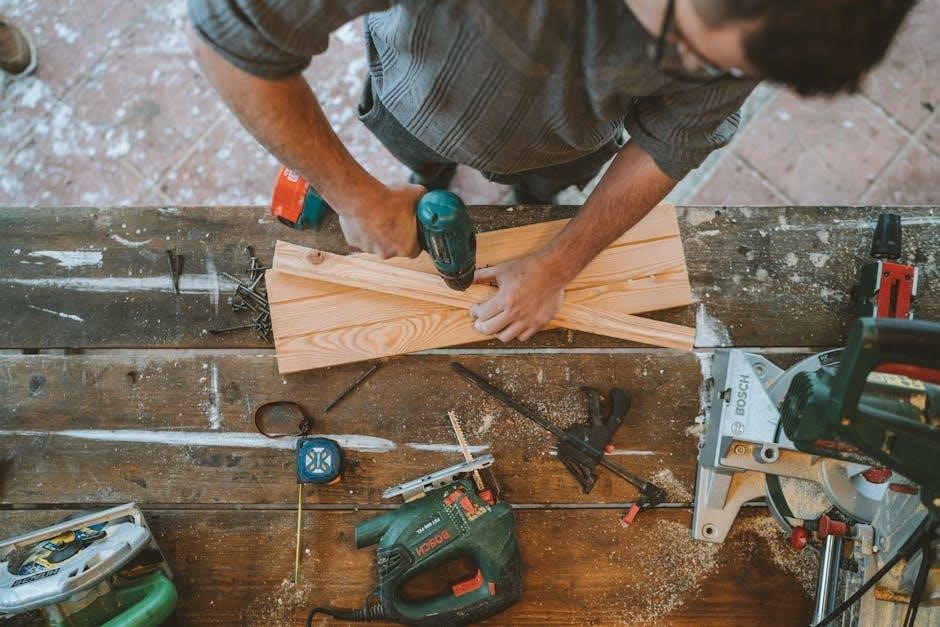
Handling the Craftsman Compound Miter Saw requires attention to detail and adherence to safety practices. Always maintain a firm grip on the saw’s handles to ensure control during operation. Keep your hands and fingers away from the blade at all times‚ as the rotating blade can cause severe injury. Use the provided fence or guide to stabilize the material being cut‚ reducing the risk of accidental contact with the blade. Avoid wearing loose clothing or jewelry that could get caught in the saw. Stand in a balanced position with good footing to prevent slipping or losing control. Never reach over the blade or lean excessively while cutting‚ as this can lead to loss of balance. After completing a cut‚ allow the blade to come to a complete stop before moving the material or adjusting the saw. Proper handling ensures safe and precise cuts every time.
Understanding the Components of the Miter Saw
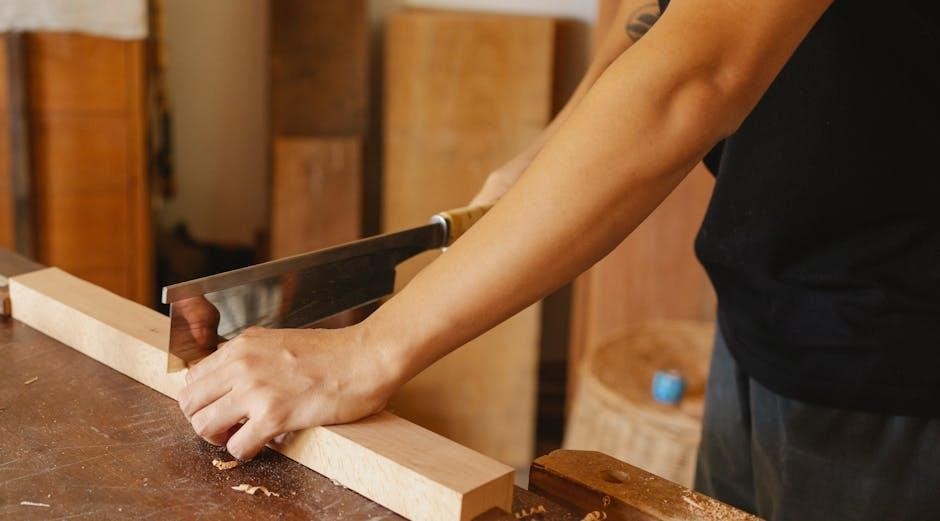
The Craftsman Compound Miter Saw features a robust design with key components like the blade‚ motor‚ fence‚ and angle adjustment knob. These parts work together to enable precise cuts and adjustments.
Main Parts and Their Functions
The Craftsman Compound Miter Saw consists of several key components designed for precision and versatility. The blade is the cutting tool‚ available in various sizes and tooth counts for different materials. The motor powers the blade‚ providing the necessary torque for smooth cuts. The fence acts as a guide‚ helping to stabilize the workpiece for accurate cuts. The miter scale allows for angle adjustments‚ enabling precise miter cuts. The bevel control lets users tilt the blade for angled cuts‚ while the laser guide provides a visual alignment aid for consistent results. Understanding these parts is essential for effective operation and maintenance of the saw.
Adjusting the Saw for Accuracy
Proper adjustment of the Craftsman Compound Miter Saw is crucial for achieving precise cuts. Start by ensuring the blade is aligned with the fence and miter scale. Use the provided wrench to tighten the blade if necessary. Next‚ calibrate the fence to ensure it is parallel to the blade‚ using the adjustment screws located at the base. For accurate miter angles‚ check the miter scale and ensure it is set to 0 degrees when the blade is aligned with the fence. Adjust the bevel control to ensure it moves smoothly and returns to 0 degrees without binding. Finally‚ align the laser guide with the blade’s cutting path for consistent results. Regularly checking and adjusting these components ensures optimal performance and accuracy in your woodworking projects.
Operating the Craftsman Compound Miter Saw
Mastering the Craftsman Compound Miter Saw involves setting it up correctly‚ making precise crosscuts‚ and adjusting angles for bevels. Utilize features like the laser guide for enhanced accuracy in every cut.
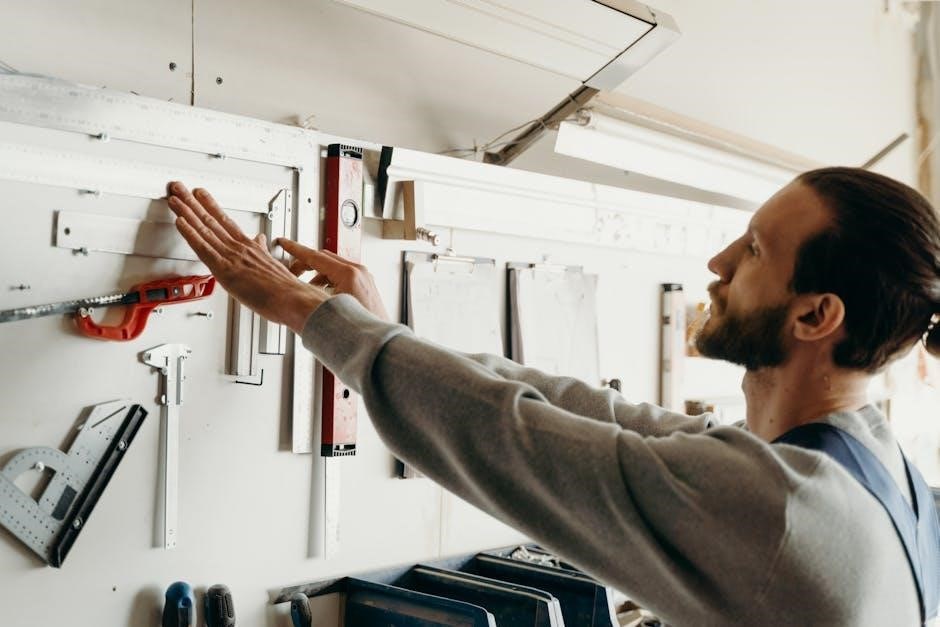
Setting Up the Saw for First Use
Before operating the Craftsman Compound Miter Saw‚ ensure proper setup for optimal performance. Begin by carefully unpacking the saw and inspecting for any damage. Assemble any included accessories‚ such as the laser guide or dust bag‚ following the manual’s instructions. Place the saw on a sturdy‚ flat surface or table to ensure stability. Align the fence and blade to guarantee accurate cuts. Calibrate the laser guide if necessary‚ using the adjustment screws to align it with the blade’s path. Install the appropriate blade‚ ensuring it is securely fastened. Double-check all bolts and components for tightness. Finally‚ test the saw on scrap material to confirm proper alignment and function. This initial setup ensures safety and precision for your first cuts.
Making Basic Crosscuts
Making basic crosscuts with the Craftsman Compound Miter Saw is straightforward when proper techniques are applied. Begin by positioning the material firmly against the fence‚ ensuring it is flush with the saw’s table. Use the laser guide to align the blade with your desired cut line for maximum accuracy. Hold the material steady with one hand and grasp the saw’s handle with the other‚ maintaining control throughout the cut. Slowly lower the blade using smooth‚ consistent pressure‚ allowing it to complete the cut without applying excessive force. After the blade finishes‚ raise it fully before releasing the material. Always ensure the saw is properly calibrated and the blade is sharp for clean‚ precise results. Practice on scrap material to refine your technique and achieve professional-quality crosscuts every time.
Cutting Angles and Bevels
Cutting angles and bevels with the Craftsman Compound Miter Saw requires precise adjustments to achieve the desired results. Begin by setting the miter angle using the control knob‚ ensuring it locks securely in place. For bevel cuts‚ tilt the saw to the specified angle and verify alignment with the laser guide. Always mark the material clearly and align it with the blade before making the cut. Use the fence as a reference for maintaining straight edges‚ and consider clamping smaller pieces for stability. Apply steady‚ controlled pressure to the saw handle‚ allowing the blade to complete the cut without rushing. For compound cuts‚ combine miter and bevel adjustments to achieve intricate angles. Practice on scrap material to master these techniques‚ ensuring clean and accurate results every time. Proper setup and alignment are key to achieving professional-quality angled and beveled cuts with ease.
Using Special Features (Laser Guide‚ etc.)
The Craftsman Compound Miter Saw is equipped with a laser guide to enhance cutting accuracy. This feature projects a red line on the workpiece‚ indicating where the blade will cut. To use it effectively‚ ensure the laser is calibrated by aligning it with the blade’s edge. Adjustments can typically be made using small screws near the laser. Additionally‚ some models include a trigger-type switch for smooth operation and a work light to illuminate the cutting area. These features help improve visibility and precision‚ especially when making intricate cuts. Always refer to the manual for specific calibration instructions‚ as improper alignment can lead to inaccurate cuts. By utilizing these special features‚ you can achieve professional-grade results with ease and confidence. Regularly check and maintain the laser and light to ensure they function optimally. Proper use of these tools will enhance your overall miter saw experience.
Maintenance and Upkeep of the Miter Saw
Regularly clean the saw‚ replacing worn blades and lubricating moving parts. This ensures smooth operation and extends the tool’s lifespan. Refer to the manual for specific maintenance guidelines.
Cleaning the Saw and Its Components

Cleaning the Craftsman Compound Miter Saw is essential for maintaining its performance and longevity. Start by turning off the saw and unplugging it for safety. Use a soft-bristle brush or a clean cloth to remove dust and debris from the blade‚ fence‚ and miter scale. Avoid using harsh chemicals‚ as they may damage the finish or components. For tougher residue‚ a mild soap solution can be applied‚ but ensure all parts are thoroughly dried afterward. Regularly inspect and clean the laser guide to maintain accuracy. Pay attention to moving parts‚ such as the pivot points‚ to prevent dust buildup. Cleaning after each use prevents sawdust from hardening and causing operational issues. Refer to the manual for specific cleaning recommendations tailored to your model. A well-maintained saw ensures precise cuts and extends its service life.
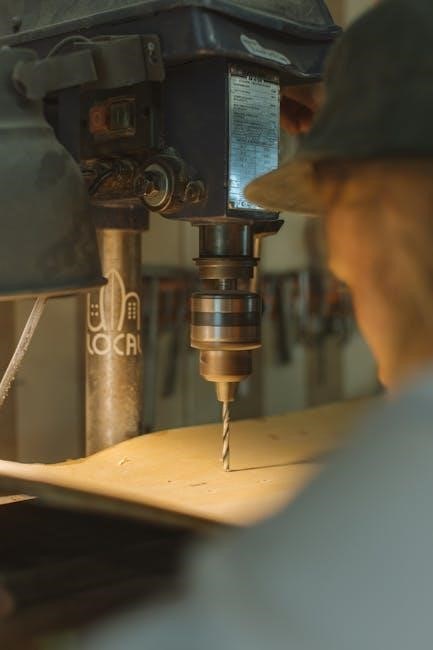
Blade Replacement and Sharpening
Blade replacement and sharpening are crucial for maintaining the performance of your Craftsman Compound Miter Saw. Over time‚ blades become dull or damaged‚ affecting cut quality. To replace the blade‚ unplug the saw and use the provided wrench to loosen the arbor nut. Carefully remove the old blade and install the new one‚ ensuring proper alignment. Tighten the arbor nut securely but avoid over-tightening. For sharpening‚ inspect the blade for dullness or damage. Use a diamond stone or professional sharpening service to restore the blade’s edge. Sharpening extends blade life and improves cutting accuracy. Always refer to the manual for specific instructions tailored to your model. Regular blade maintenance ensures precise cuts and prolongs the saw’s efficiency. Proper care of the blade is essential for optimal performance and safety.
Lubricating Moving Parts
Lubricating the moving parts of your Craftsman Compound Miter Saw is essential for smooth operation and longevity. Regular lubrication reduces friction‚ prevents wear‚ and ensures precise cuts. Focus on pivot points‚ gears‚ and the arbor. Use a silicone-based spray lubricant‚ as it resists drying out and protects against corrosion. Apply a light coat to moving components‚ then wipe off any excess with a clean cloth. Avoid over-lubrication‚ as it can attract dust and debris. Lubricate after cleaning or every 50 hours of use. Always unplug the saw before lubricating to ensure safety. Proper lubrication maintains the saw’s performance and prevents premature wear on critical parts. Refer to the manual for specific lubrication points and recommendations tailored to your model. Regular maintenance ensures the saw operates efficiently and delivers accurate results. Keep the saw well-lubricated to uphold its durability and cutting precision. This step is vital for maintaining optimal functionality.

Troubleshooting Common Issues
Identify symptoms like inaccurate cuts or motor issues. Check blade alignment‚ tighten loose parts‚ and ensure proper setup. Refer to the manual for specific solutions to restore optimal performance.
Common Problems and Solutions
Common issues with the Craftsman Compound Miter Saw include blade misalignment‚ uneven cuts‚ and motor malfunctions. For blade misalignment‚ recalibrate the fence and blade to ensure accuracy. Uneven cuts may result from a dull blade; replace it with a sharp‚ high-quality blade. Motor issues often stem from overheating or electrical problems; ensure proper ventilation and check power connections. If the laser guide is not functioning‚ refer to the manual for alignment instructions or replace the laser if damaged. Regular maintenance‚ such as cleaning and lubricating moving parts‚ can prevent many of these issues. Always consult the manual for specific troubleshooting steps and solutions to maintain optimal performance and extend the tool’s lifespan. Addressing these problems promptly ensures precise cuts and reliable operation.

Blade Alignment and Calibration
Proper blade alignment and calibration are crucial for accurate cuts with the Craftsman Compound Miter Saw. Start by ensuring the blade is parallel to the fence and aligned with the laser guide. If misaligned‚ refer to the manual for adjustment steps. Loosen the adjustment screws‚ align the blade using a wrench or tool‚ and tighten securely. Calibration ensures the saw delivers precise angles and bevels. Use the provided calibration tool or a combination square to verify alignment. Regular checks prevent drift over time. If the blade wobbles or cuts unevenly‚ recalibrate immediately. Proper alignment enhances cutting accuracy and extends blade life. Always follow the manual’s specific calibration instructions for optimal performance. Misalignment can lead to unsafe operation and poor results‚ making this step essential for both safety and productivity. Keep the saw well-maintained to ensure consistent‚ professional-grade cuts every time. Calibration is a simple process that pays off in precision and reliability.
Motor and Electrical Issues
Addressing motor and electrical issues in your Craftsman Compound Miter Saw is essential for maintaining performance and safety. Common problems include a malfunctioning motor‚ faulty switches‚ or electrical connectivity issues. If the motor doesn’t start‚ check the power cord and outlet for damage or blockages. Ensure the switch is functioning properly and free from debris. If the motor overheats‚ allow it to cool before resuming use. For persistent issues‚ consult the manual or contact a professional. Regularly inspect electrical components for wear and tear. Replace any damaged cords or switches promptly. Proper maintenance prevents electrical hazards and ensures reliable operation. Always follow safety guidelines when troubleshooting to avoid accidents. If unsure‚ refer to the manual or seek assistance from a certified technician. Keeping the motor and electrical system in good condition is vital for the longevity and efficiency of your miter saw. Addressing these issues promptly ensures smooth and safe operation.
